Crafting SEO article with 20 wildflower garden sections3sThe user wants me to create an SEO-optimized article about "20 Wildflower Garden Ideas". Let me break down the requirements:
I need to research the topic thoroughly with 4-5 online searches
Create 20 H2 sections (since they want exactly the number mentioned in the keyword - 20 ideas)
Each section should be 100-120 words
Introduction max 100 words, conclusion max 100 words
Each heading should include the core keyword phrase "wildflower garden"
Structure: intro, 20 numbered H2 sections, conclusion
Use varied opening sentences
Avoid inappropriate content
Let me start by researching wildflower gardens to understand different types, styles, and approaches.I'll research wildflower garden ideas thoroughly to create a comprehensive, SEO-optimized article for you. Let me gather information about different types, styles, and approaches to wildflower gardening.wildflower garden ideas types styles10 resultsGreat! I have gathered good information about wildflower gardens. 1sGreat! I have gathered good information about wildflower gardens. Now let me search for more specific ideas and design styles to get 20 unique wildflower garden ideas.cottage wildflower garden designs styles10 resultsBrainstormed wildflower garden and container gardening ideas.1sNow let me search for more specific wildflower garden ideas and container gardening aspects to fill out my 20 ideas.container wildflower garden vertical slope wildflower designs10 resultsNow let me search for a few more specific wildflower garden ideas to complete my list of 20 ideas, 1sNow let me search for a few more specific wildflower garden ideas to complete my list of 20 ideas, including seasonal and design-focused approaches.cutting wildflower garden rock garden border wildflower designs10 resultsMapped out 20 unique wildflower garden design concepts.4sI now have enough comprehensive information to create 20 unique wildflower garden ideas. Based on my research, I can identify various types and styles of wildflower gardens including:
Cottage-style wildflower garden
Meadow wildflower garden
Container wildflower garden
Slope/hillside wildflower garden
Pollinator-friendly wildflower garden
Shaded wildflower garden
Vertical wildflower garden
Fence border wildflower garden
Cutting wildflower garden
Native wildflower garden
Seasoned/seasonal wildflower garden
Prairie-style wildflower garden
Rock garden wildflower combination
Orchard underplanting wildflower garden
Mixed border wildflower garden
Pathways wildflower garden
Butterfly and hummingbird wildflower garden
Pocket wildflower garden
Self-seeding wildflower garden
Front yard wildflower garden
Let me now write the comprehensive article with proper structure, ensuring each section is 100-120 words and includes the keyword "wildflower garden" in each heading as requested.Based on my research, I'll create a comprehensive article about 20 wildflower garden ideas. Here's your SEO-optimized article:
Creating a wildflower garden transforms any outdoor space into a vibrant ecosystem that supports local wildlife while requiring minimal maintenance. These natural sanctuaries offer endless possibilities for gardeners seeking low-maintenance beauty that changes with the seasons. From sprawling meadows to compact container displays, wildflower gardens adapt to various spaces and skill levels. They provide essential habitats for pollinators, reduce water consumption, and create stunning visual displays throughout multiple seasons. Whether you're working with a small urban balcony or acres of rural property, wildflower gardens offer sustainable solutions that connect your landscape to the natural world around you.
1. Cottage-Style Wildflower Garden
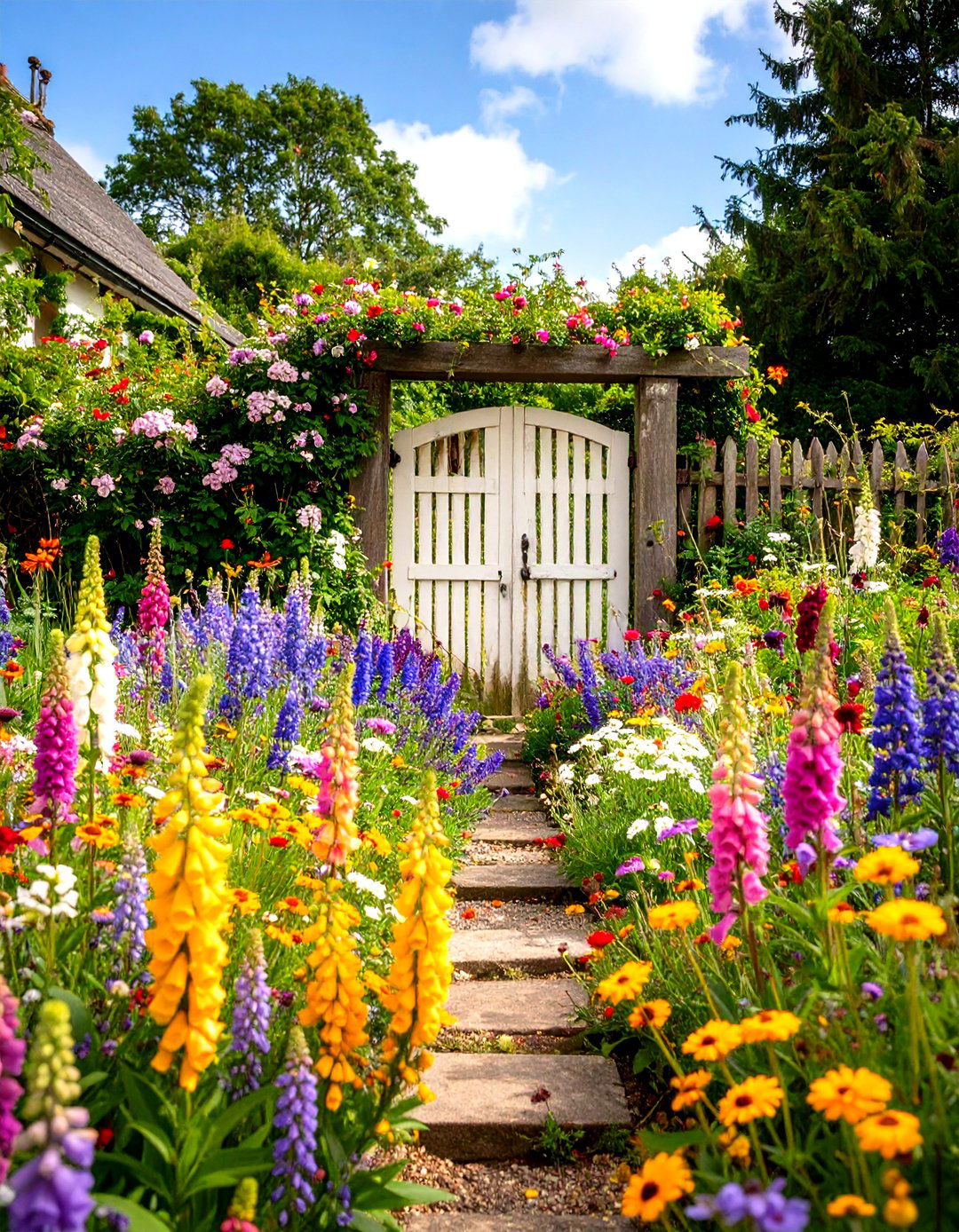
Combining the romantic charm of traditional cottage gardens with native wildflowers creates an enchanting landscape overflowing with color and texture. This cottage-style wildflower garden features densely packed blooms including foxgloves, delphiniums, and sweet william alongside climbing roses and fragrant herbs. Unlike formal cottage gardens, this approach allows plants to self-seed and naturalize, creating a more relaxed atmosphere. Layer plants by height with shorter varieties like sweet alyssum in front, medium-height cosmos in the center, and tall hollyhocks providing backdrop structure. Incorporate meandering pathways through the plantings and add vintage elements like weathered trellises or antique garden gates. The key is balancing controlled chaos with intentional design, allowing nature to fill gaps while maintaining underlying structure.
2. Prairie-Style Wildflower Garden

A prairie-style wildflower garden recreates the expansive beauty of natural grasslands with deep-rooted perennials and native grasses. This design emphasizes drought-tolerant species like purple coneflowers, black-eyed susans, and little bluestem grass that thrive in challenging conditions. Plant in sweeping drifts rather than individual specimens to mimic natural prairie communities. Include varying heights from low-growing wild bergamot to towering big bluestem grass, creating movement and visual interest. These wildflower gardens require minimal water once established and provide excellent habitat for birds and beneficial insects. Allow plants to go to seed naturally, providing food for wildlife through winter months. Annual maintenance involves cutting back growth in late winter before new shoots emerge.
3. Container Wildflower Garden

For urban dwellers or renters, a container wildflower garden offers flexibility and instant impact on patios, balconies, or rooftops. Choose compact varieties like dwarf cosmos, California poppies, and baby snapdragons that adapt well to pot cultivation. Use various container sizes and materials to create visual interest, mixing terracotta pots with galvanized buckets or wooden planters. Ensure proper drainage and use quality potting mix designed for containers. Position containers strategically to create layered displays, placing taller plants toward the back. This wildflower garden style allows experimentation with different combinations each season. Include trailing varieties to soften container edges and create spillover effects. Regular watering and occasional feeding keep container wildflowers thriving throughout the growing season.
4. Slope Wildflower Garden
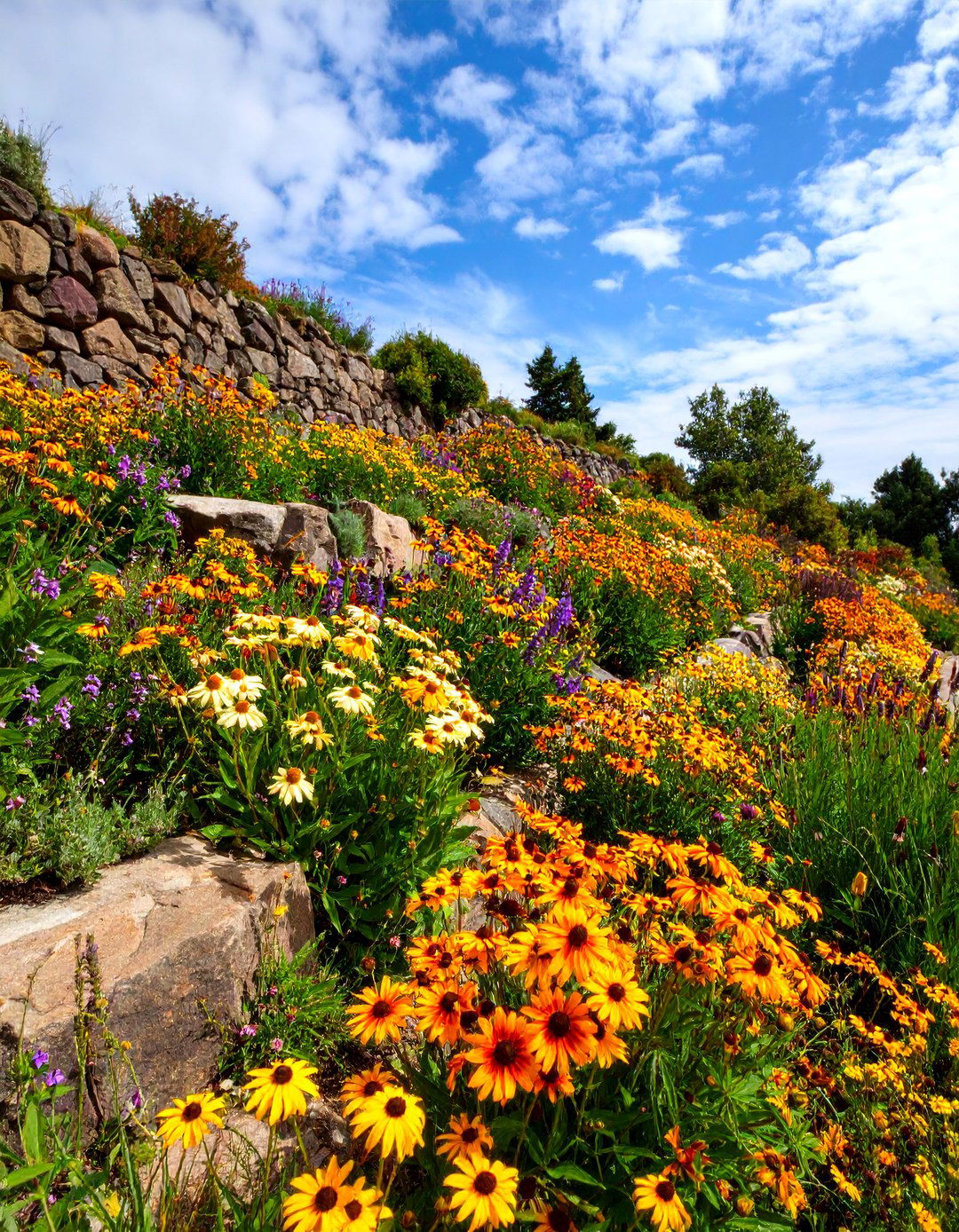
Transform challenging hillsides into stunning displays with a slope wildflower garden that prevents erosion while providing seasonal beauty. Deep-rooted species like goldenrod, coreopsis, and butterfly weed anchor soil effectively while creating cascading waves of color down the incline. This practical solution eliminates difficult mowing on steep terrain and reduces maintenance requirements significantly. Choose plants specifically adapted to slope conditions, considering drainage patterns and sun exposure. Layer plantings with groundcover varieties at the top transitioning to taller species lower down the slope. Annual wildflowers provide quick establishment while perennials develop strong root systems. The naturalistic appearance enhances landscape integration while providing valuable wildlife habitat and reducing runoff during heavy rainfall events.
5. Shade-Tolerant Wildflower Garden
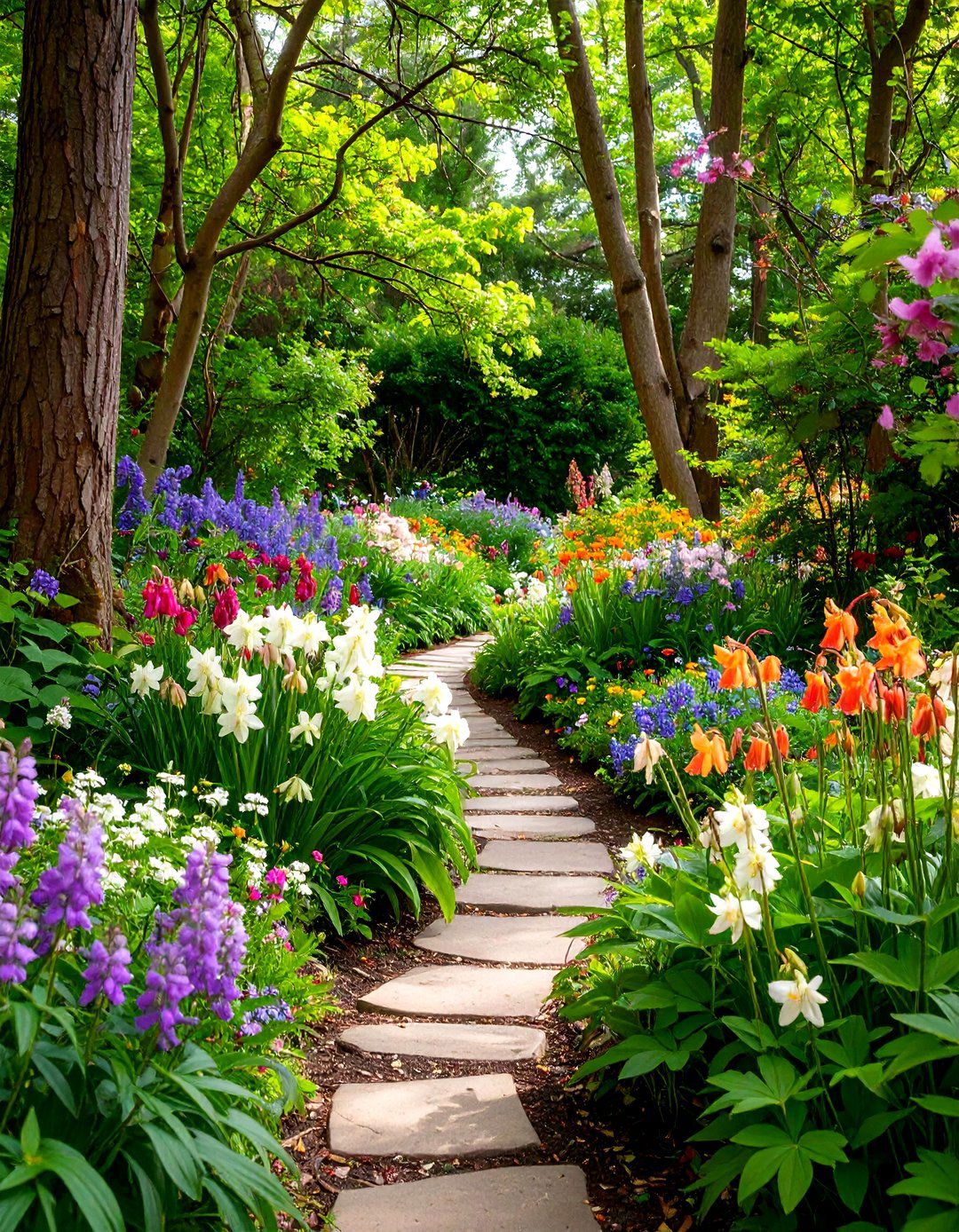
Woodland areas and shaded spaces become vibrant ecosystems with a shade-tolerant wildflower garden featuring species adapted to low-light conditions. Columbines, bleeding hearts, and woodland phlox thrive beneath tree canopies, bringing color to previously underutilized spaces. These wildflower gardens require less watering than sunny locations and offer unique opportunities for delicate, ephemeral blooms. Include early spring varieties like Virginia bluebells that flower before trees leaf out, maximizing available light. Add foliage plants like wild ginger and foamflower for continued interest after blooms fade. Create meandering paths through shade plantings to encourage exploration. The cool, moist environment supports different pollinator species while providing peaceful retreat spaces. Mulch paths help retain moisture and prevent soil compaction.
6. Vertical Wildflower Garden
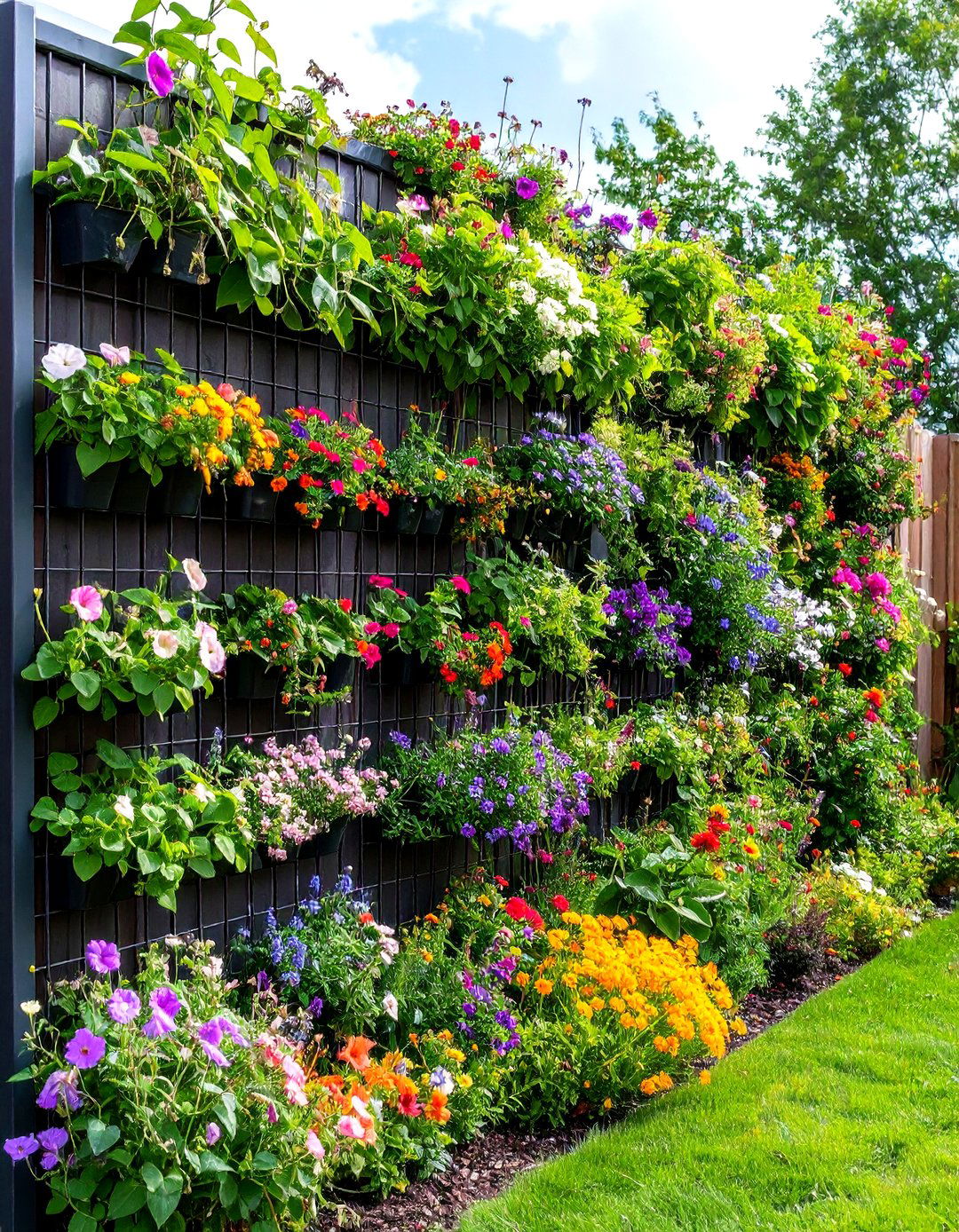
Maximize limited space with a vertical wildflower garden using walls, fences, or specially designed structures to support climbing and trailing varieties. Sweet peas, morning glories, and wild clematis create living walls that attract pollinators while providing privacy screening. Install trellises, wire mesh, or modular planting systems to support vertical growth. Include cascading varieties in elevated planters for waterfall effects. This approach works exceptionally well for urban environments where ground space is limited. Combine annual climbers for quick coverage with perennial vines for long-term structure. Vertical wildflower gardens cool surrounding areas, reduce noise pollution, and create microclimates for beneficial insects. Regular watering and periodic pruning maintain healthy growth and flowering throughout the season.
7. Pollinator-Focused Wildflower Garden

Design a pollinator-focused wildflower garden specifically to support bees, butterflies, and hummingbirds with carefully selected native species that provide nectar throughout the growing season. Include milkweed for monarch butterflies, bee balm for hummingbirds, and asters for late-season pollinators. Plant in clusters rather than scattered individuals, making nectar sources easier for pollinators to locate. Avoid pesticides and herbicides completely to maintain safe feeding environments. Provide shallow water sources and bare soil patches for butterfly puddling. Include host plants for butterfly larvae alongside nectar sources. This wildflower garden supports declining pollinator populations while creating dynamic, ever-changing displays as different species visit throughout the seasons. Leave seed heads standing through winter to provide food for birds and overwintering sites for beneficial insects.
8. Mixed Border Wildflower Garden
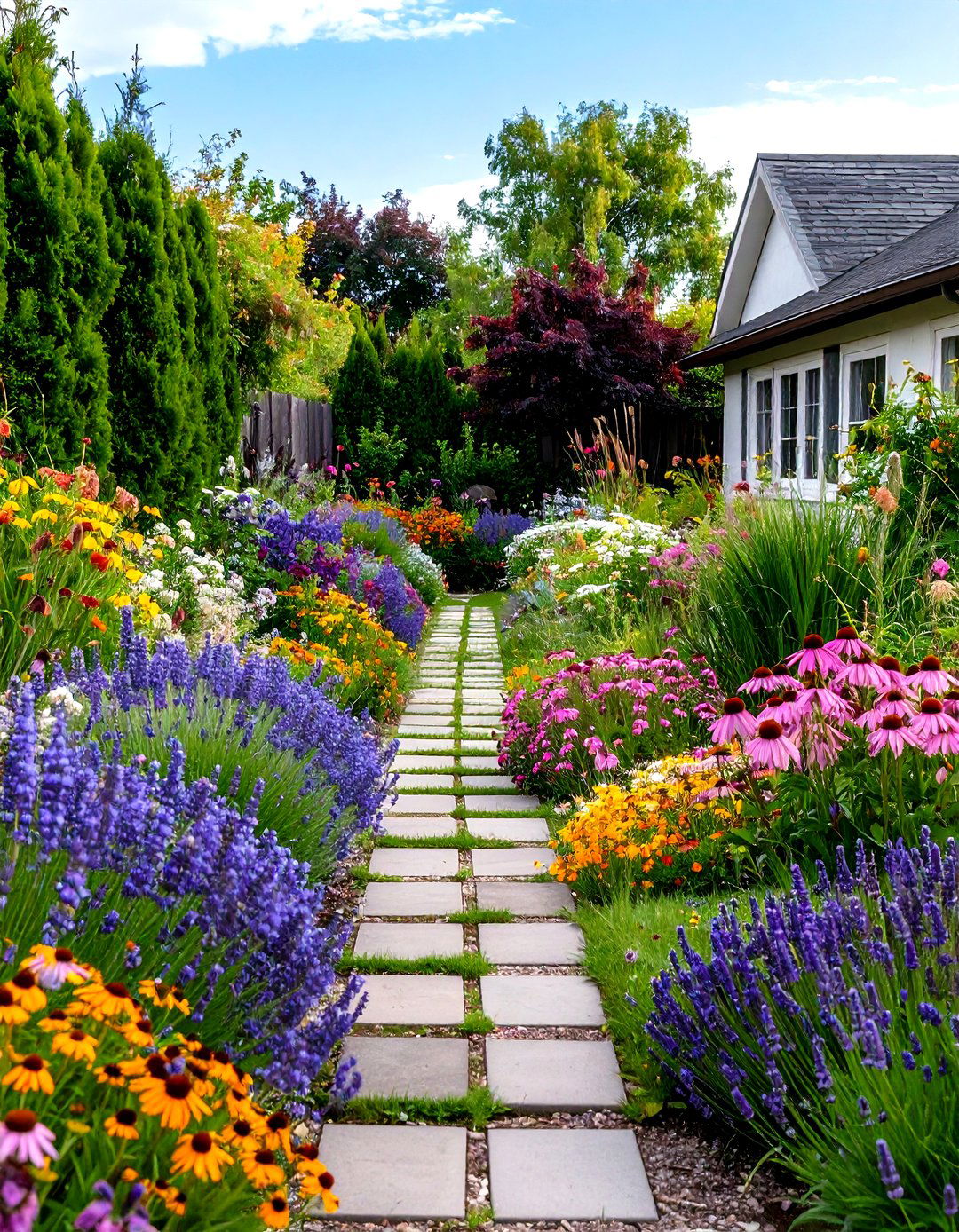
A mixed border wildflower garden combines cultivated perennials with native wildflowers, creating structured yet naturalistic plantings along garden edges or property boundaries. This approach softens formal landscape elements while introducing beneficial wildlife habitat. Blend traditional garden favorites like lavender and rosemary with native alternatives like wild bergamot and purple coneflower. Maintain height relationships with shorter edging plants, medium-height fillers, and tall backdrop specimens. The mixed approach allows gradual transition from formal garden areas to more naturalistic spaces. Include evergreen shrubs for winter interest and year-round structure. This wildflower garden style accommodates various maintenance levels, with formal sections requiring more care while naturalized areas develop independently. Seasonal cleanup focuses on removing spent growth while allowing self-seeding species to establish naturally.
9. Seasonal Succession Wildflower Garden

Plan a seasonal succession wildflower garden to ensure continuous blooms from early spring through late fall using carefully timed plantings of annuals and perennials. Early spring bulbs like crocuses and winter aconites provide initial color, followed by summer annuals like zinnias and cosmos, finishing with fall-blooming asters and goldenrod. This succession approach maximizes visual impact throughout the growing season while supporting pollinators during critical periods. Include plants with varying bloom times within each season for extended displays. Fast-growing annuals fill gaps while slower perennials establish. Plan color combinations that complement each season's natural palette. This wildflower garden requires more initial planning but provides months of changing beauty. Document flowering times to refine plantings for future seasons and optimize succession timing.
10. Meadow Wildflower Garden
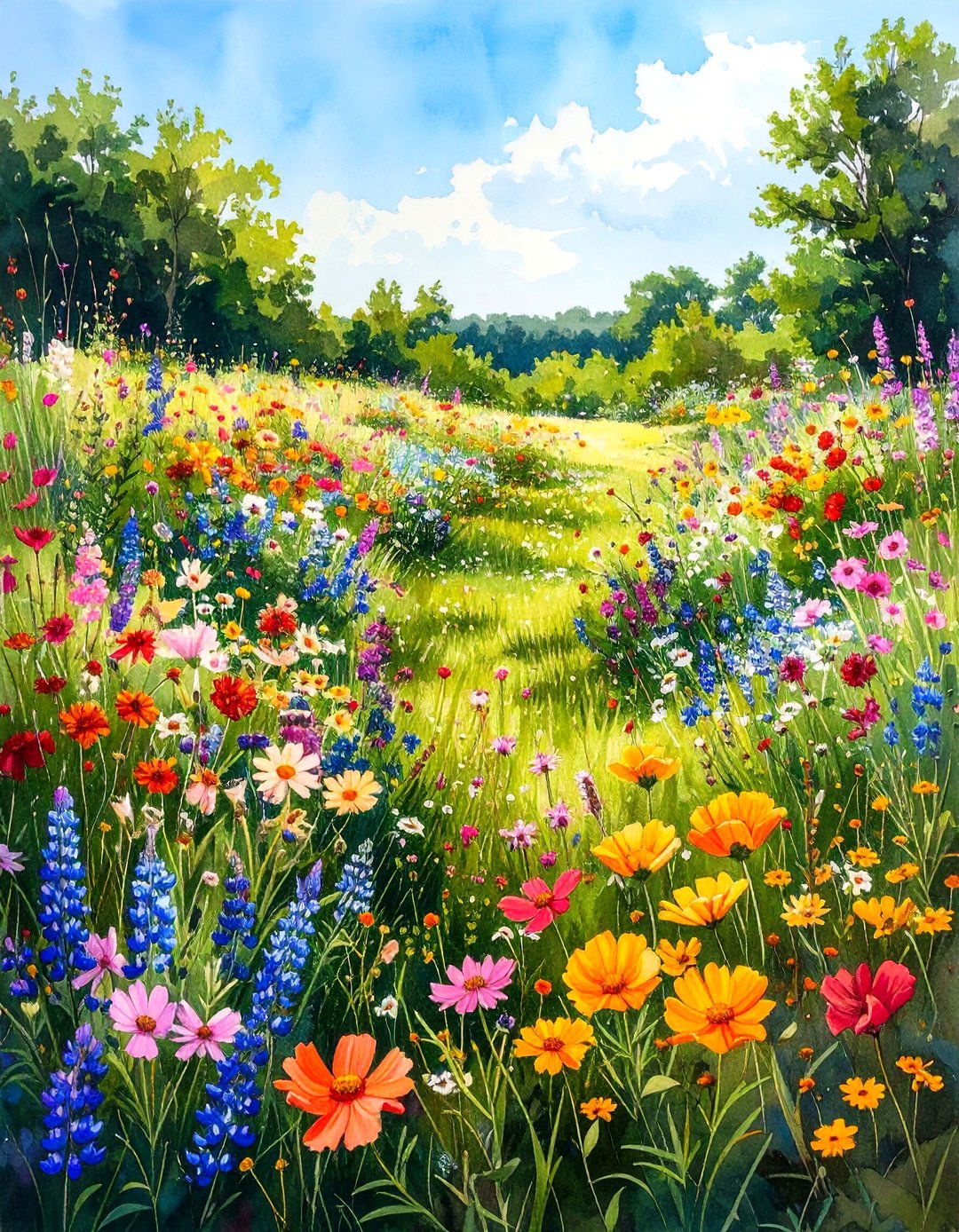
Create an expansive meadow wildflower garden that mimics natural grassland ecosystems with native grasses and broadleaf wildflowers planted in naturalistic drifts. This large-scale approach works best with significant acreage, creating habitat corridors for wildlife while providing stunning seasonal displays. Include both cool-season and warm-season grasses alongside diverse wildflower species. Allow natural selection to determine final plant communities over several years. Establish mown pathways through the meadow for access and visual structure. This wildflower garden requires annual cutting in late winter but otherwise maintains itself through natural processes. The meadow approach supports ground-nesting birds, small mammals, and countless insect species. Vary topography where possible to create microhabitats for different plant communities and increase overall biodiversity.
11. Rock Garden Wildflower Garden
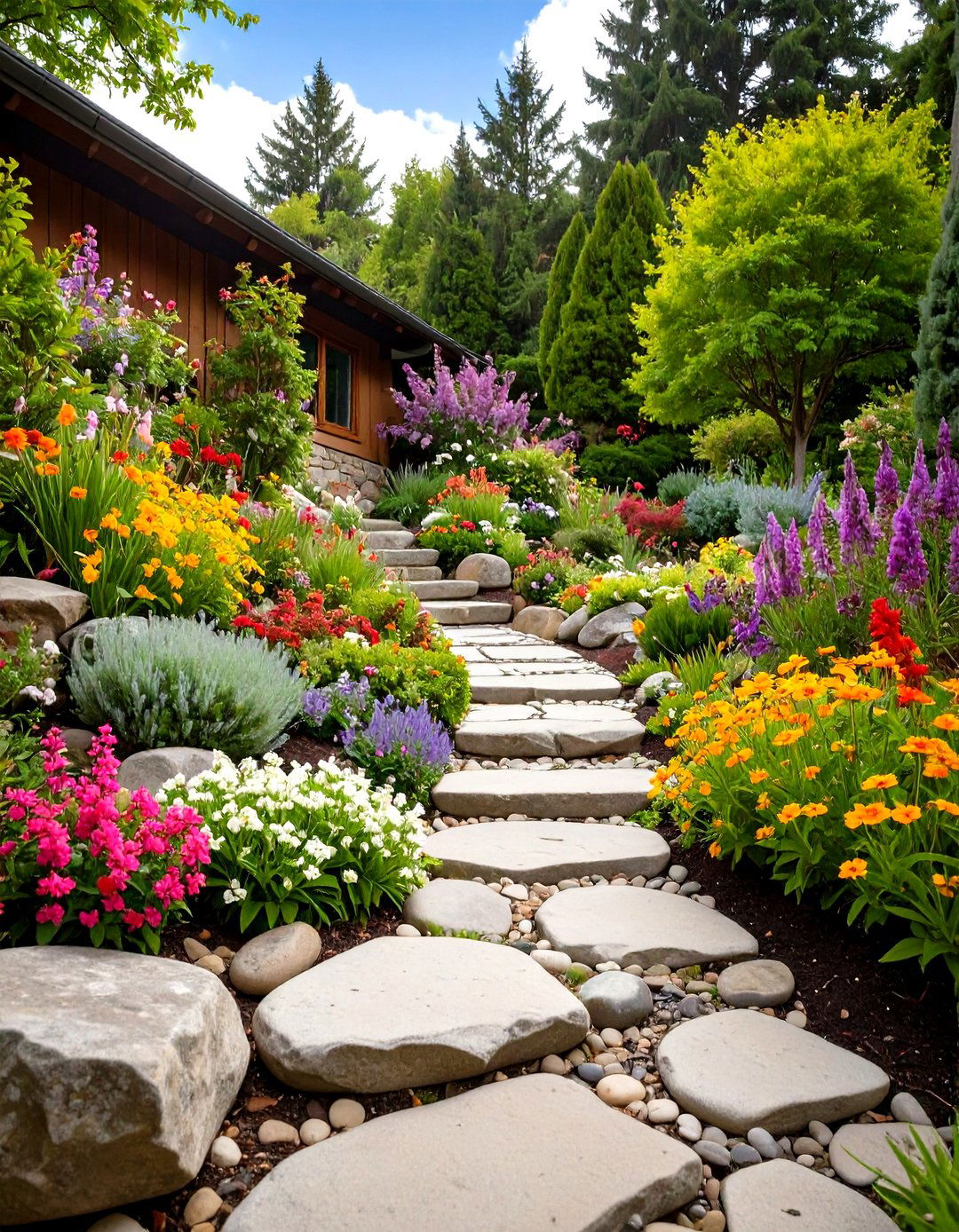
Combine alpine and prairie wildflowers with natural stone features in a rock garden wildflower garden that thrives in well-drained conditions. This approach suits sloped sites, raised areas, or anywhere enhanced drainage is desired. Use native stones to create terraces, retaining walls, or scattered boulder groupings. Plant drought-tolerant species like wild columbine, penstemon, and sedum between rocks. The stones provide thermal mass, moderate soil temperatures, and create microclimates for different species. Include gravel mulches that complement stone colors while improving drainage around plant crowns. This wildflower garden style requires excellent drainage but minimal irrigation once established. Rock features provide overwintering sites for beneficial insects and basking spots for reptiles. The combination of stone and wildflowers creates year-round interest even during dormant seasons.
12. Cutting Wildflower Garden
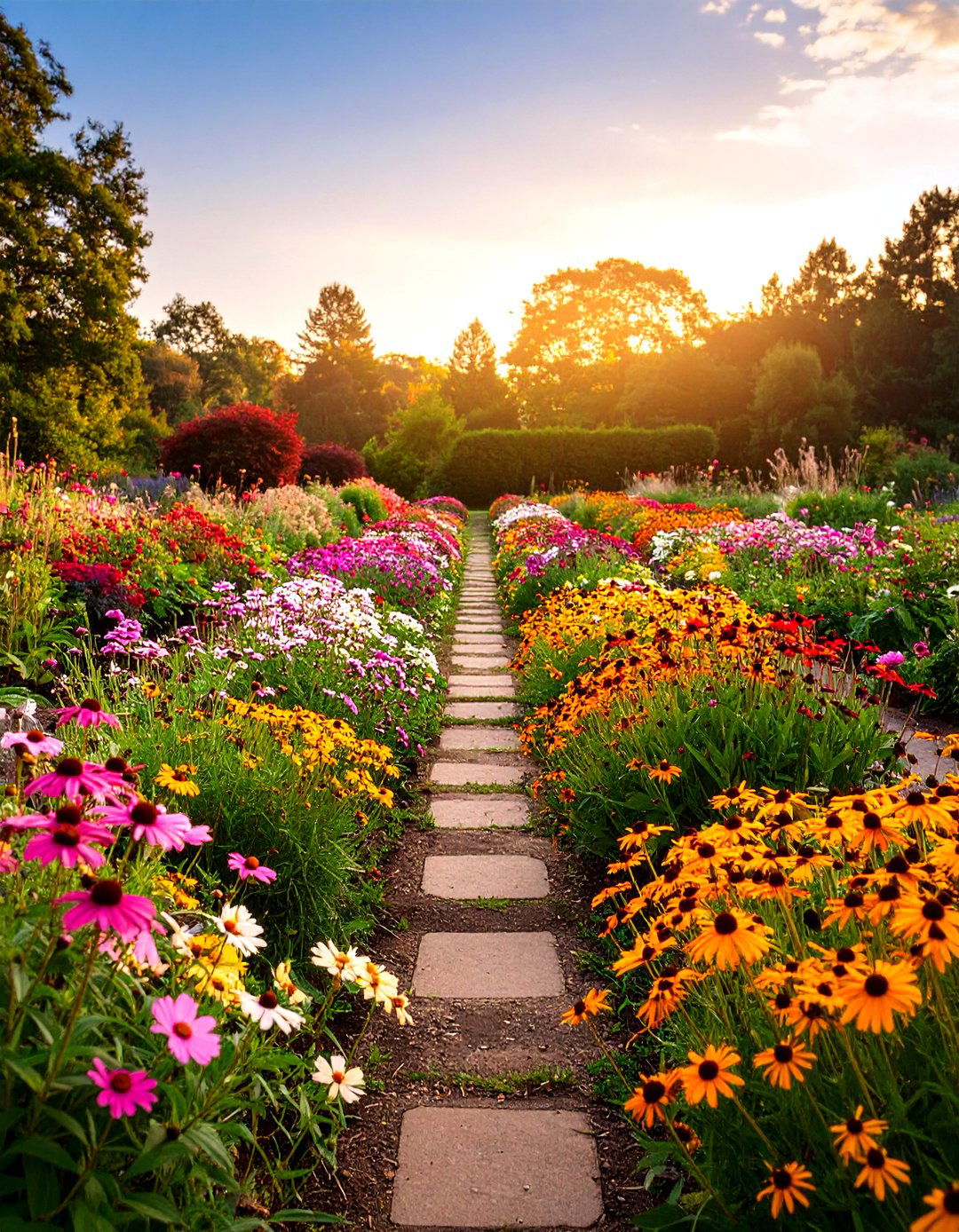
Establish a cutting wildflower garden specifically designed to provide fresh flowers for indoor arrangements while supporting outdoor pollinators. Focus on species with strong stems and good vase life like zinnias, cosmos, sunflowers, and black-eyed susans. Plant in rows or blocks for easier harvesting rather than naturalistic drifts. Include foliage plants like artemisia and grasses for texture in arrangements. This approach allows regular harvesting without compromising overall garden appearance. Choose varieties specifically bred for cutting with longer stems and better post-harvest longevity. Succession plant annuals every few weeks for continuous bloom production. This wildflower garden serves dual purposes, beautifying both indoor and outdoor spaces. Plan color combinations that work well together in arrangements while providing diverse nectar sources for beneficial insects visiting the garden.
13. Front Yard Wildflower Garden
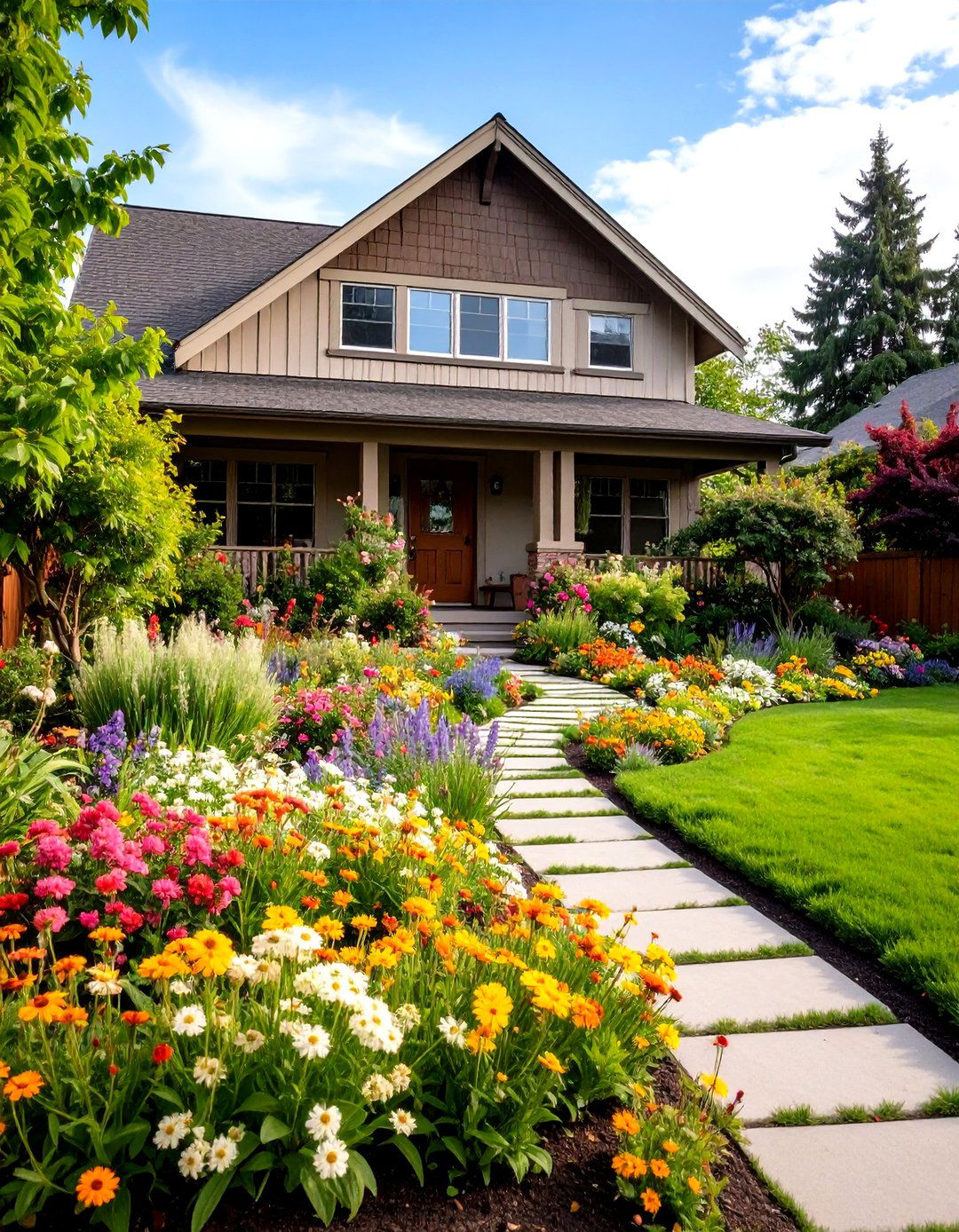
Replace traditional lawn with a front yard wildflower garden that reduces maintenance while creating stunning curb appeal and neighborhood conversation starters. Choose regionally appropriate native species that provide four-season interest and require minimal supplemental watering. Include structural elements like defined pathways, border edging, or specimen trees to maintain neat appearance and neighbor acceptance. This approach significantly reduces mowing, fertilizing, and watering requirements while supporting local wildlife. Plan for varying heights and textures that look intentional rather than neglected. Include some evergreen elements for winter structure. Consider local ordinances and homeowner association requirements when planning. This wildflower garden demonstrates environmental stewardship while creating unique landscape character. Provide educational signage about native plants and wildlife benefits to engage community interest and support.
14. Orchard Underplanting Wildflower Garden
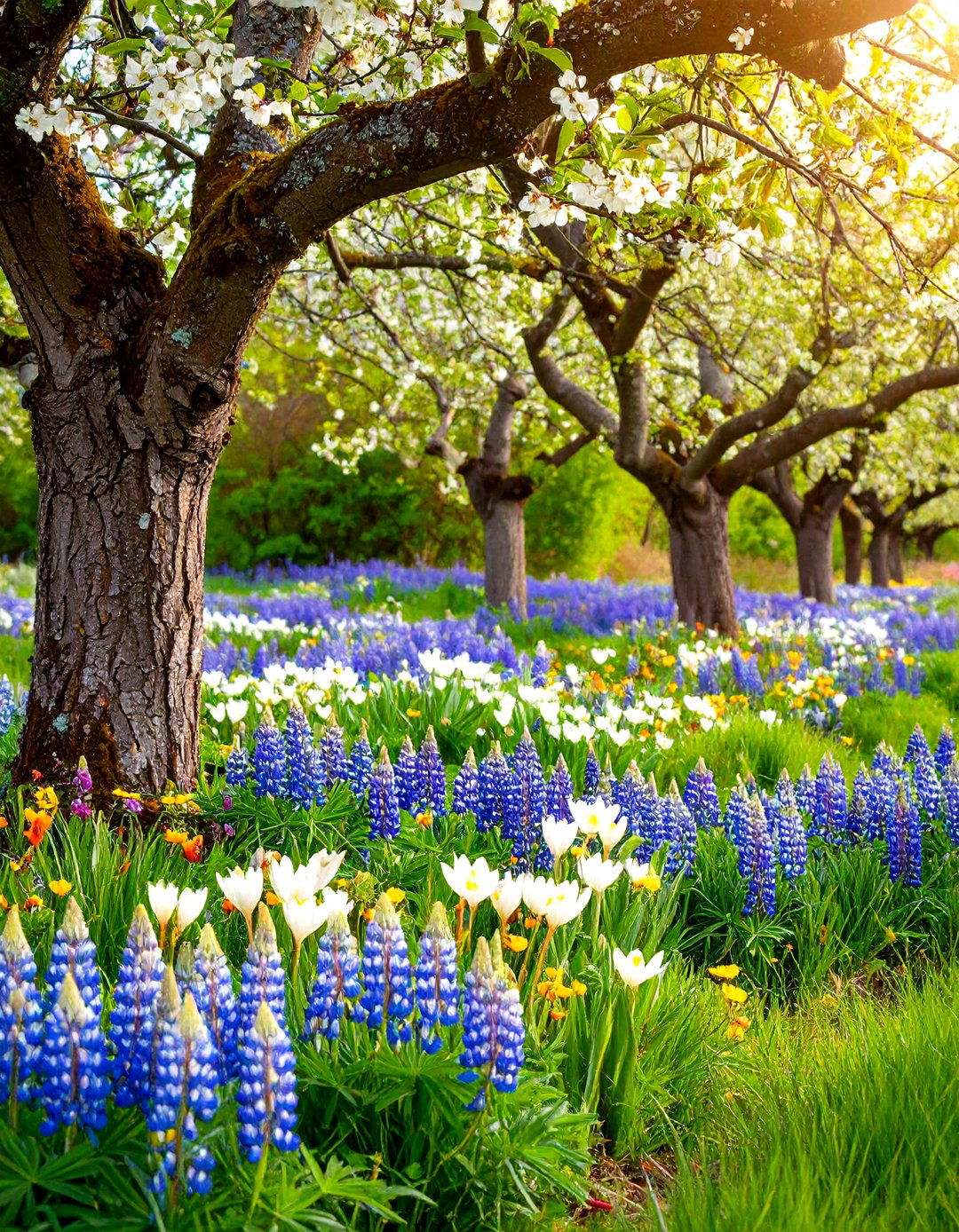
Transform the space beneath fruit trees into productive habitat with an orchard underplanting wildflower garden that supports both crop pollination and biodiversity. Plant early-blooming species like crocuses and wild lupine to provide nectar during fruit tree flowering periods. Include species that tolerate root competition and partial shade conditions found beneath mature trees. This approach eliminates mowing challenges around tree trunks while creating beneficial insect habitat. Choose plants that don't compete aggressively with tree roots or interfere with harvest activities. The wildflower garden provides ground cover that conserves soil moisture and prevents erosion. Include plants with different bloom times to support pollinators throughout the season. Maintain clear areas around tree trunks for air circulation and pest management. This integration creates productive, beautiful landscapes that support both human food production and natural ecosystems.
15. Fence Line Wildflower Garden

Create linear beauty and wildlife corridors with a fence line wildflower garden that softens boundary structures while maximizing growing space. This approach works well along property lines, providing privacy screening and pollinator pathways between garden areas. Choose heights appropriate to fence elevation, using tall varieties like sunflowers and joe-pye weed against tall fences, medium species against mid-height barriers. Include climbing varieties that can use fence structures for support without causing damage. This wildflower garden creates visual continuity while defining property boundaries naturally. Plant in varying depths to create layered effects and accommodate different moisture and light conditions along the fence line. Include some evergreen or persistent plants for winter interest. The linear format makes maintenance easier while providing significant wildlife habitat in relatively narrow spaces.
16. Butterfly and Hummingbird Wildflower Garden
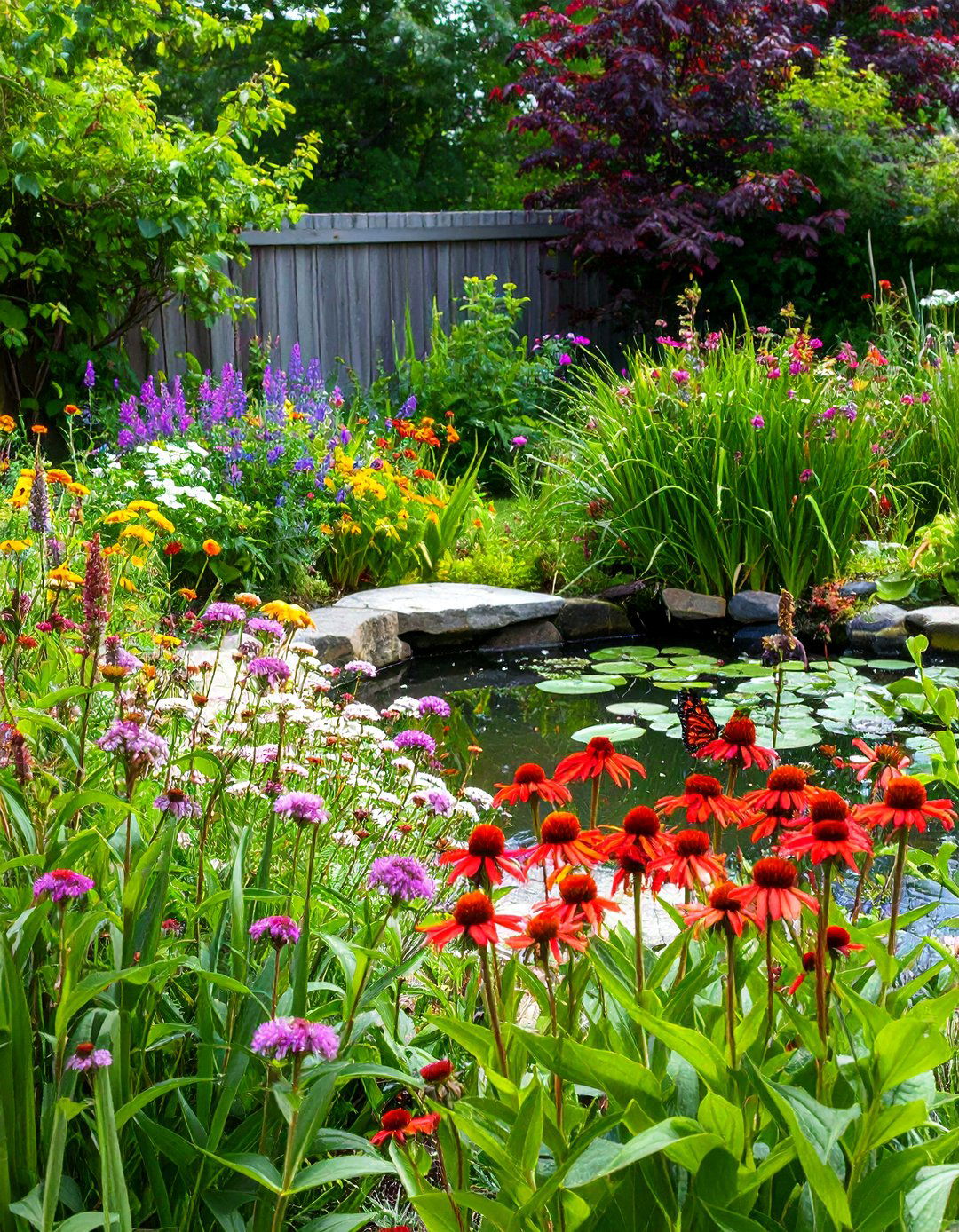
Design a butterfly and hummingbird wildflower garden with specific attention to flower shapes, colors, and nectar production that attracts these beautiful visitors. Include tubular flowers like bee balm and cardinal flower for hummingbirds, flat-topped flowers like yarrow and asters for butterflies. Plant in sunny, sheltered locations that provide basking spots and protection from strong winds. Include host plants like milkweed for butterfly reproduction alongside nectar sources. Provide shallow water features and mud puddles for butterfly minerals. This wildflower garden creates dynamic, ever-changing displays as different species visit throughout the day and season. Avoid pesticides completely to maintain safe environments for these sensitive species. Include plants with overlapping bloom times to provide consistent nectar sources. Position seating areas nearby for comfortable wildlife observation and garden enjoyment.
17. Pocket Wildflower Garden
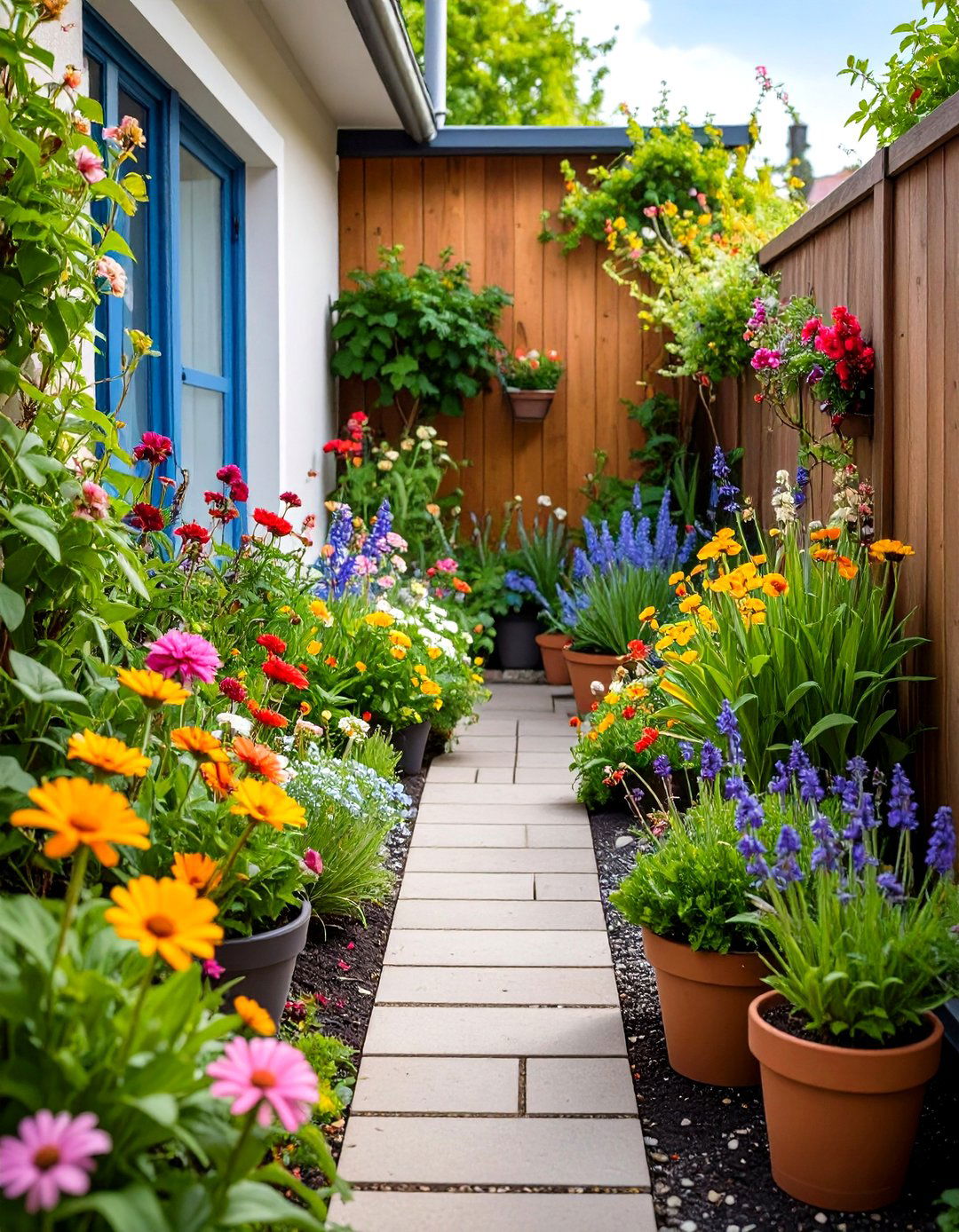
Utilize small spaces effectively with a pocket wildflower garden that transforms unused corners, narrow strips, or neglected areas into vibrant displays. These compact gardens prove that significant impact doesn't require extensive space. Choose compact varieties and organize plantings for maximum visual effect in limited areas. Include vertical elements like trellises or tall, narrow plants to maximize growing space. This approach works excellently for urban environments, rental properties, or experimental plantings. Focus on high-impact species with long bloom periods or striking foliage. The small scale allows for more intensive management and experimentation with unusual species combinations. This wildflower garden can serve as gateway plantings that introduce neighbors to native plant benefits. Design for easy maintenance access since these gardens often occupy high-visibility locations requiring consistent appearance.
18. Self-Seeding Wildflower Garden
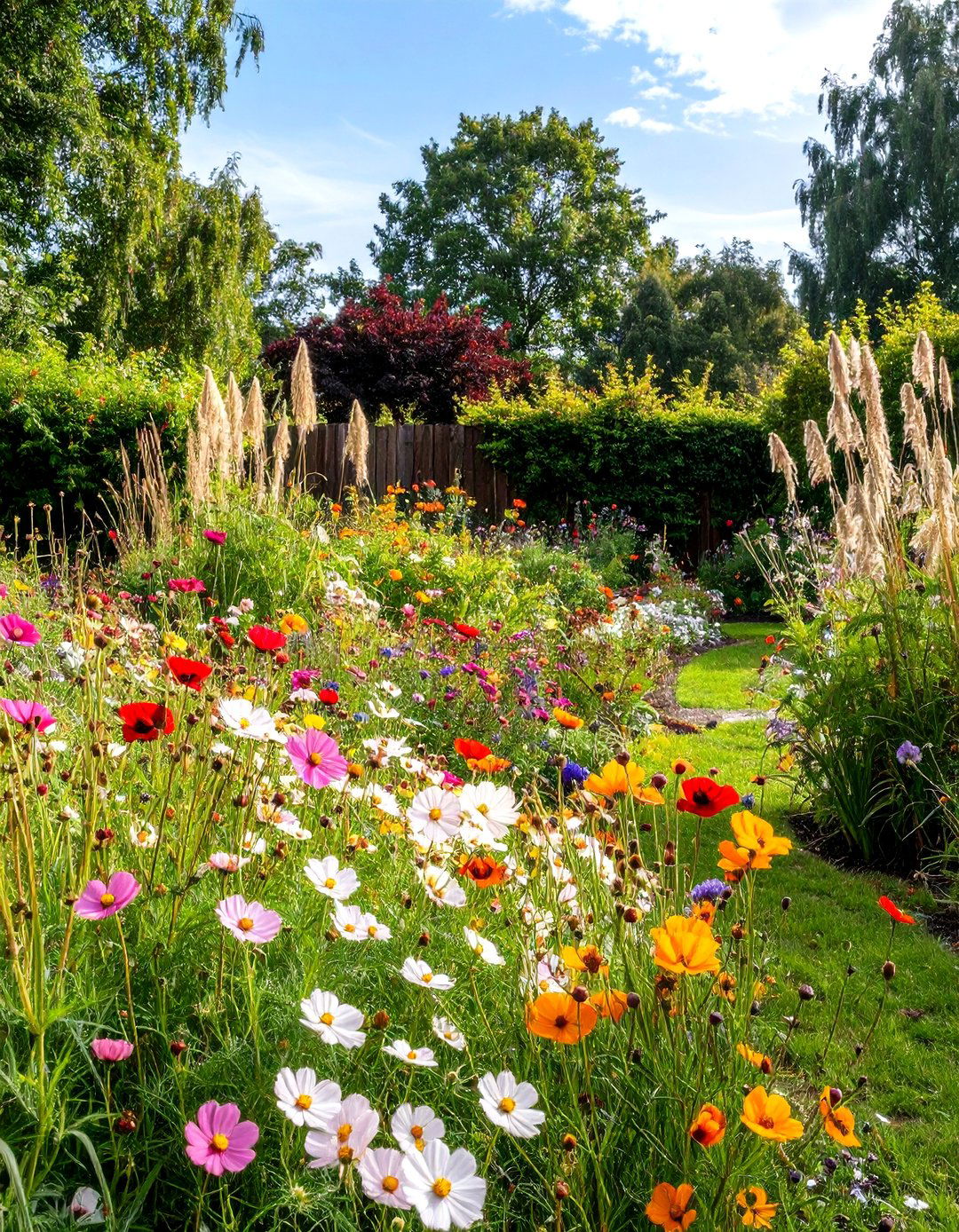
Develop a self-seeding wildflower garden that perpetuates itself naturally through plants that readily drop seeds and establish new generations without replanting. Include prolific seeders like cosmos, bachelor buttons, and poppies that adapt to various conditions and fill available spaces. This approach creates evolving plant communities that change composition over time through natural selection. Allow seed heads to remain through winter for wildlife food and natural reseeding. Light soil disturbance in spring helps seeds germinate while controlling overly aggressive species. This wildflower garden requires minimal annual input once established but benefits from occasional editing to maintain desired plant balance. The unpredictable nature creates garden surprises as plants appear in unexpected locations. Include some longer-lived perennials to provide stability within the changing annual population. Document changes over time to understand natural succession patterns.
19. Drought-Tolerant Wildflower Garden

Create sustainable landscapes with a drought-tolerant wildflower garden featuring species adapted to minimal water availability once established. Include native plants specifically evolved for local precipitation patterns and soil conditions. This approach reduces irrigation demands while creating resilient plantings that thrive during dry periods. Choose species with deep root systems, succulent leaves, or other water-conservation adaptations. Mulch heavily to conserve soil moisture and moderate soil temperatures. This wildflower garden becomes increasingly beautiful and self-sufficient as plants mature and root systems develop. Include plants with silver or gray foliage that reflects heat and conserves moisture. Group plants by water needs to optimize irrigation efficiency during establishment. The sustainable approach demonstrates environmental responsibility while creating unique beauty adapted to local climate conditions.
20. Multi-Season Interest Wildflower Garden
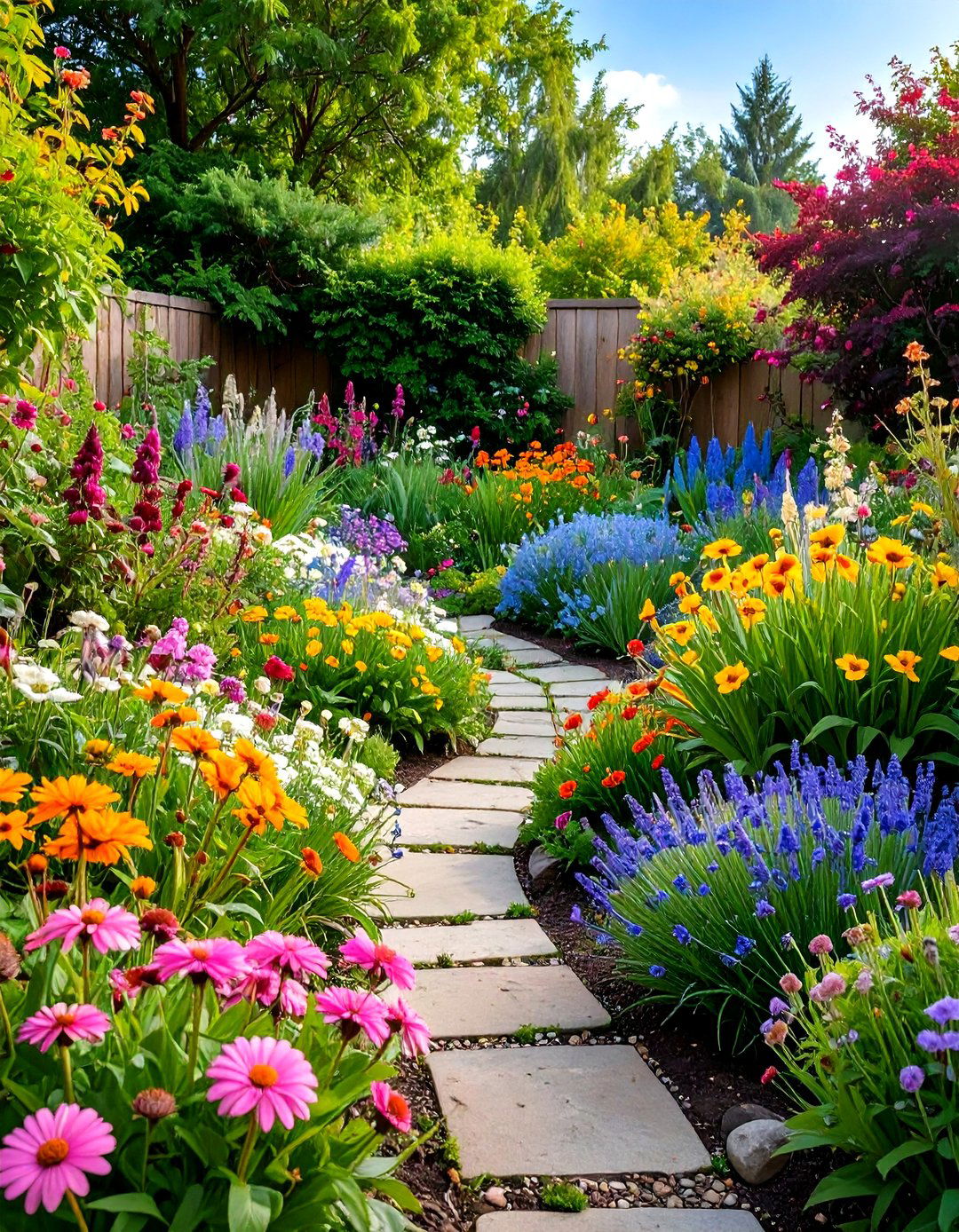
Design a multi-season interest wildflower garden that provides year-round beauty through careful selection of plants offering flowers, foliage, seed heads, and winter structure. Include early spring bulbs, summer perennials, fall-blooming asters, and plants with attractive winter silhouettes. This comprehensive approach ensures garden value throughout the year rather than just peak bloom periods. Choose plants with multiple seasons of interest, like ornamental grasses that provide summer texture, fall color, and winter structure. Include evergreen elements for consistent green presence. This wildflower garden planning requires understanding each plant's complete annual cycle and designing for sequential displays. Leave seed heads and dried stems through winter for wildlife food and shelter. Plan pathways that provide access for winter observation and maintenance. The four-season approach creates landscapes that reward year-round attention and provide continuous wildlife support.
Conclusion:
Wildflower gardens offer endless possibilities for creating beautiful, sustainable landscapes that support local ecosystems while requiring minimal maintenance. From expansive prairie meadows to compact container displays, these versatile plantings adapt to various spaces, budgets, and skill levels. The key to success lies in selecting appropriate native species, preparing sites properly, and allowing natural processes to guide development. Whether you choose a single approach or combine multiple styles, wildflower gardens provide lasting beauty, wildlife habitat, and connection to the natural world. Start small, observe what thrives in your conditions, and gradually expand your wildflower gardening adventures as confidence and experience grow.


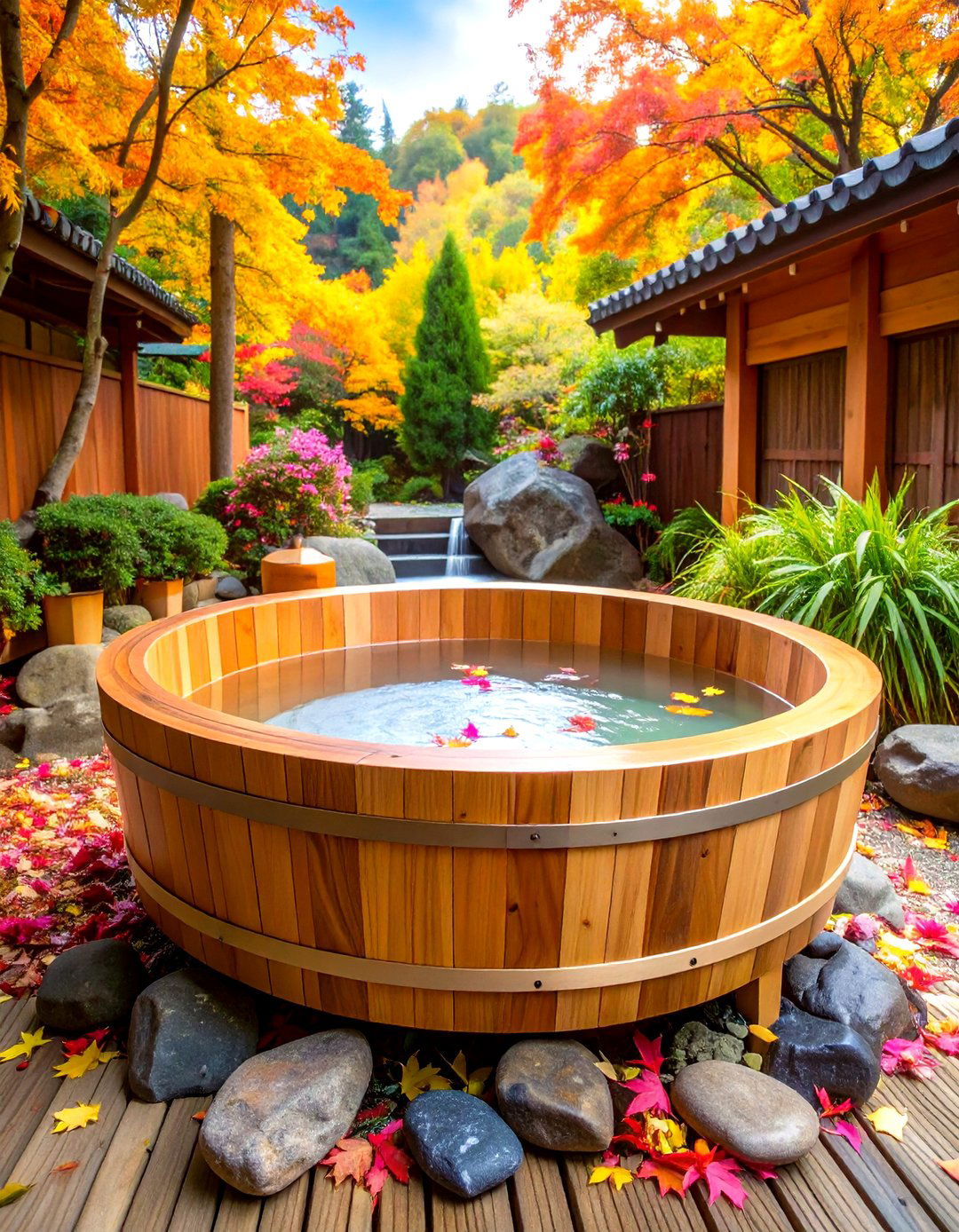

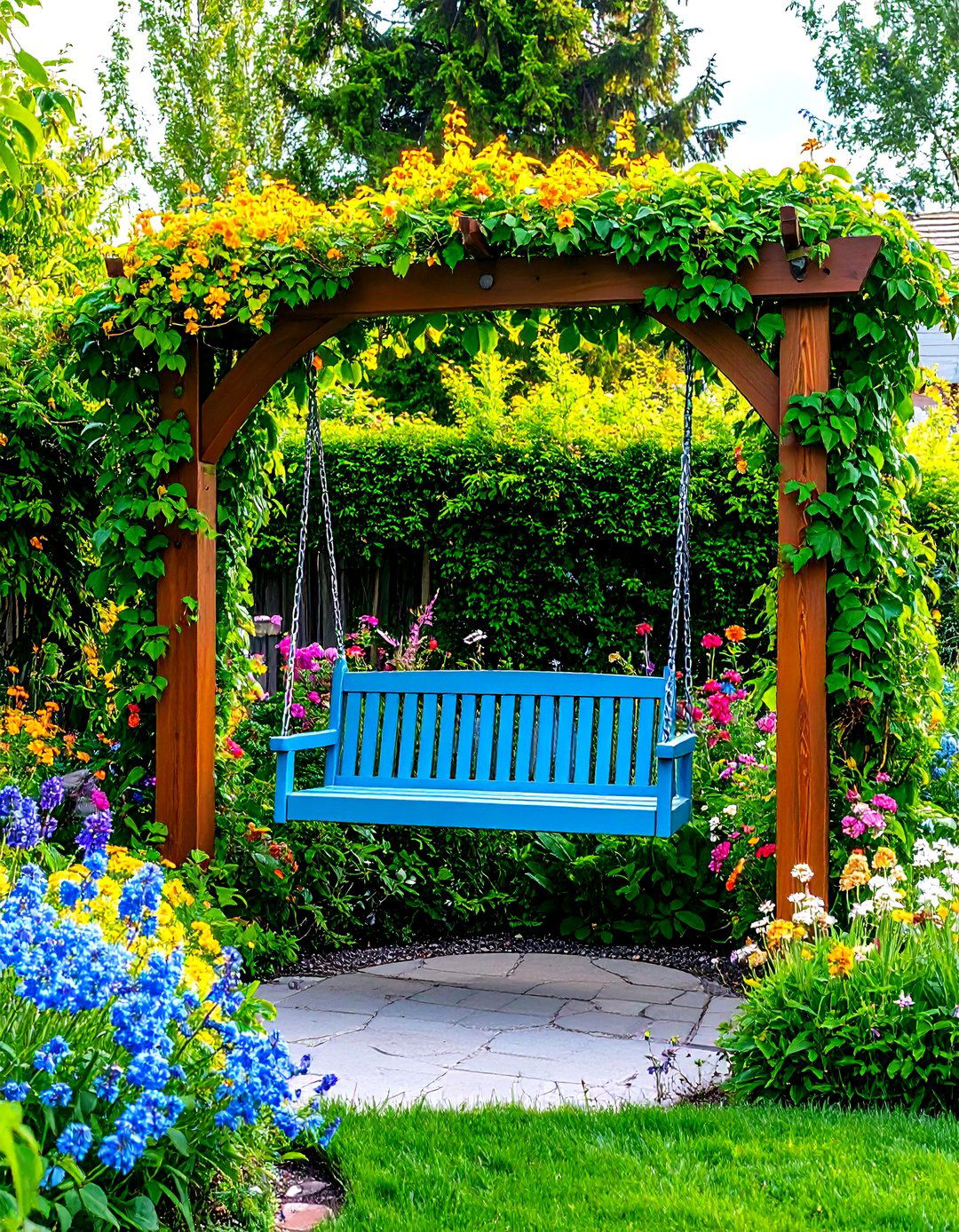
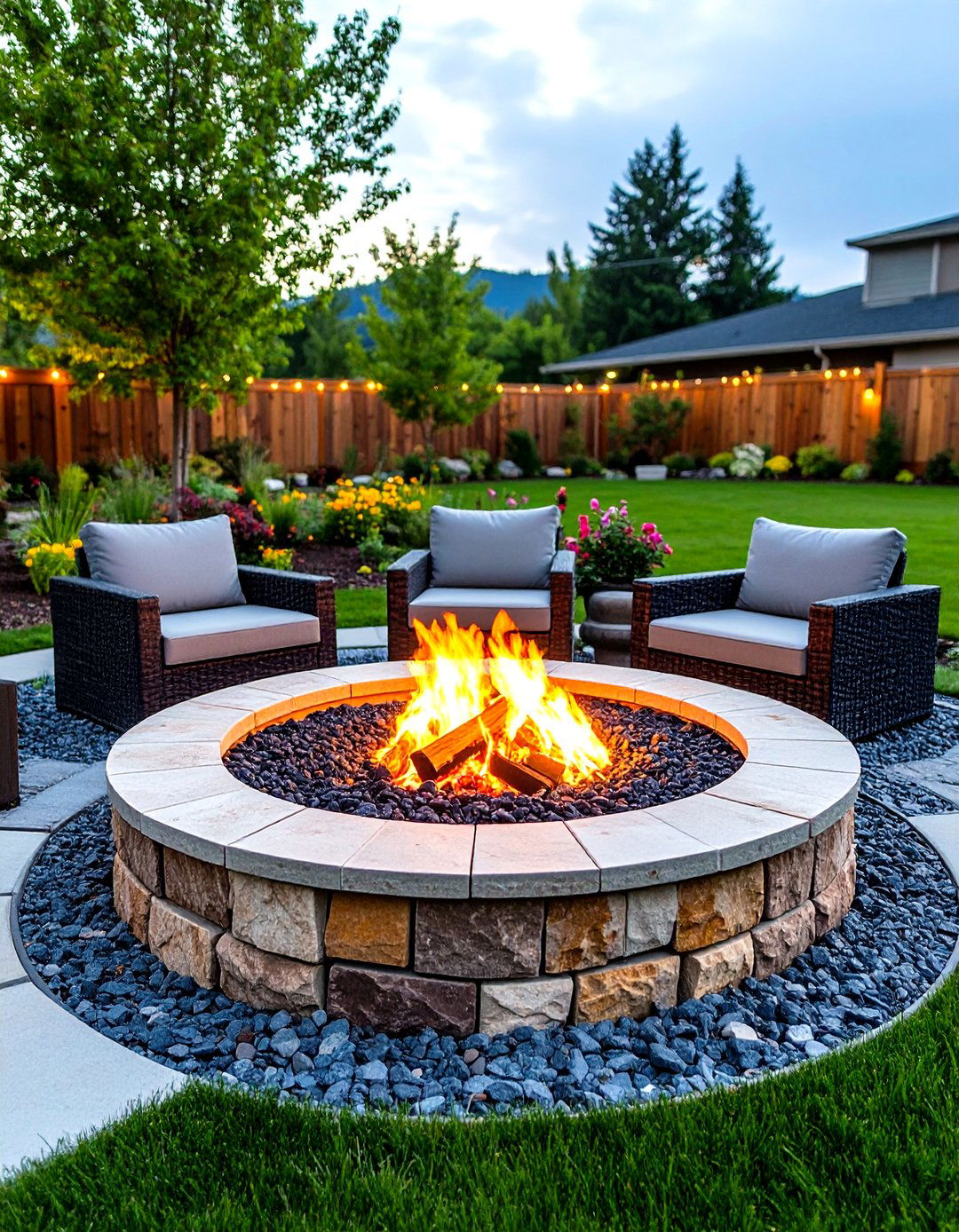
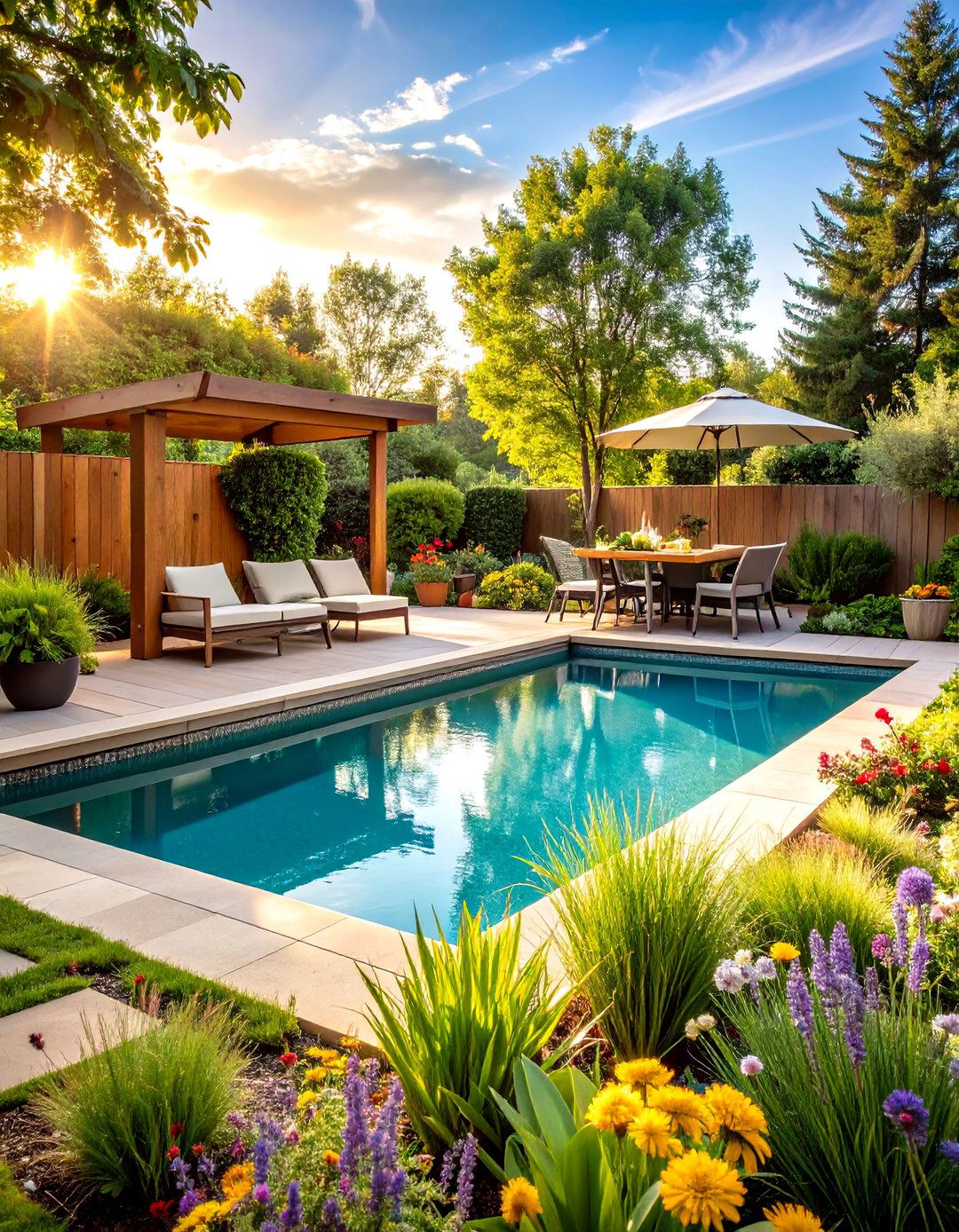
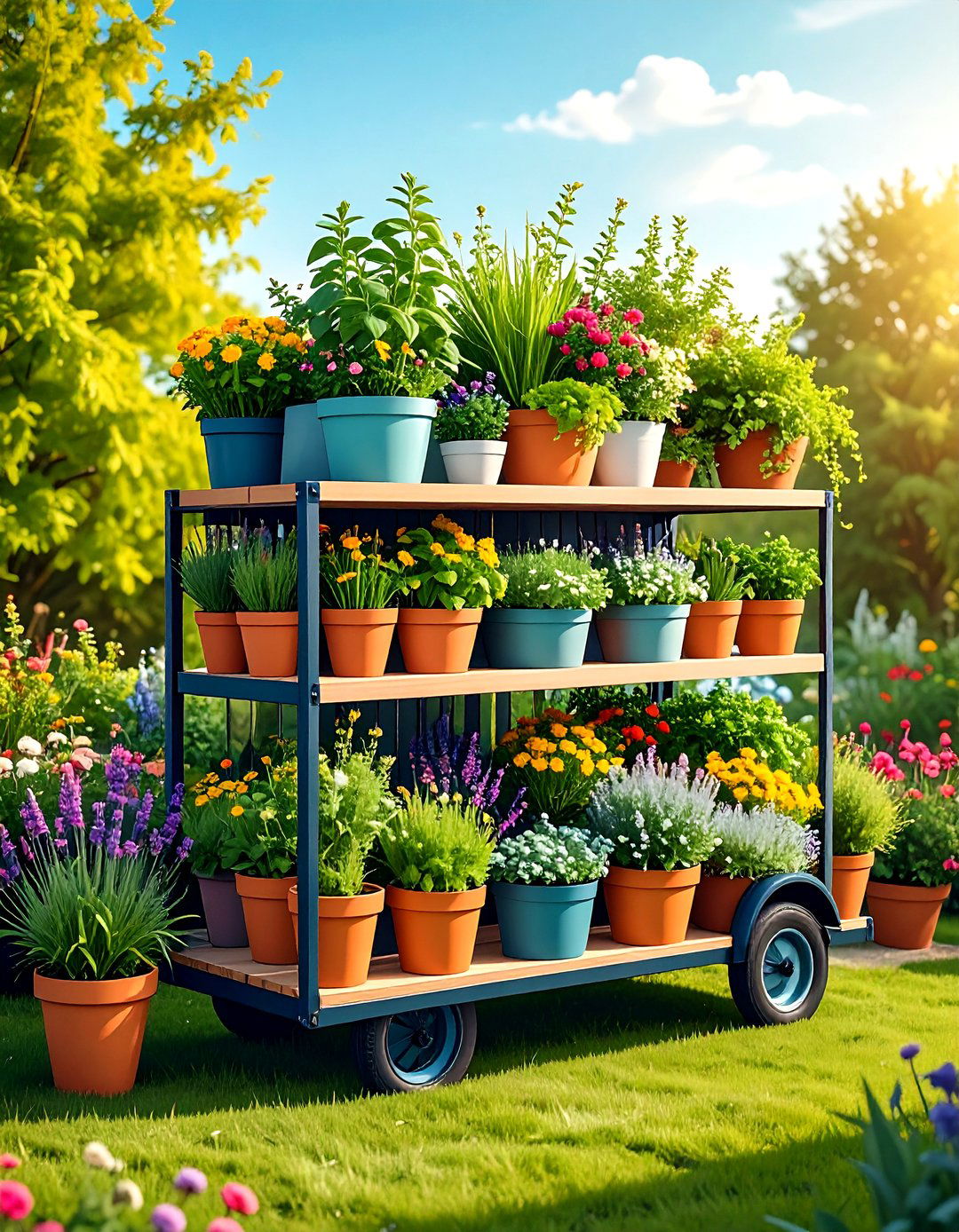
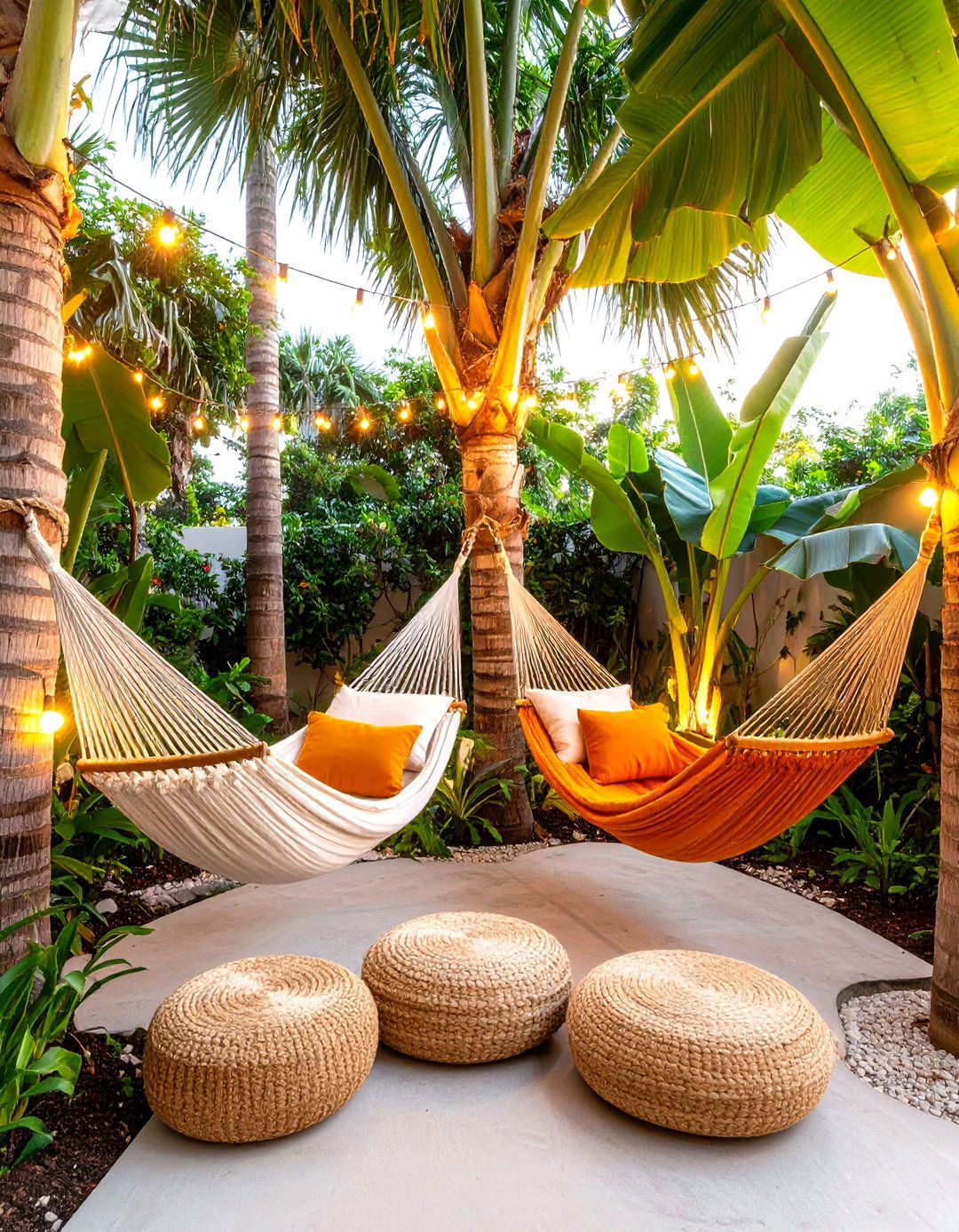




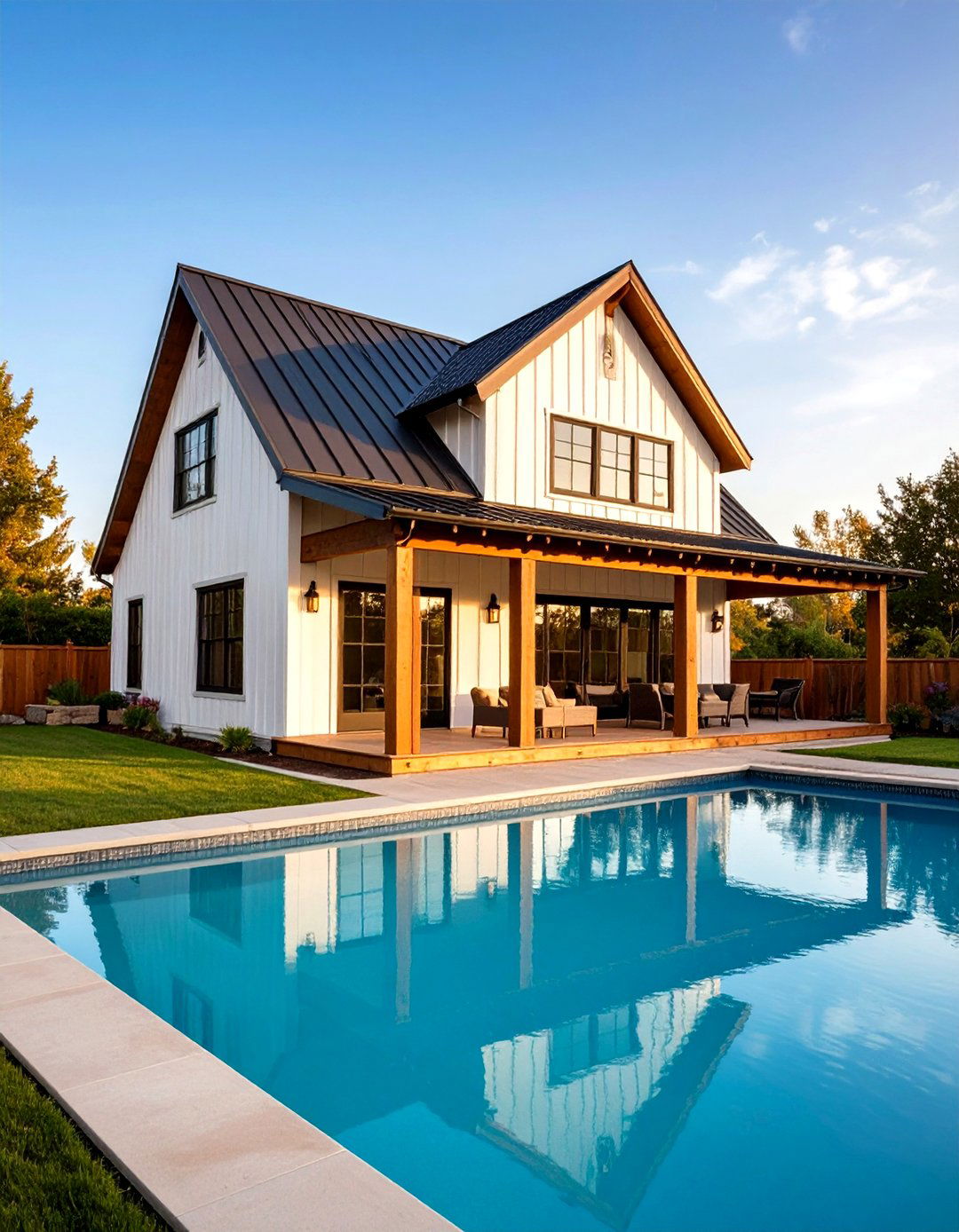
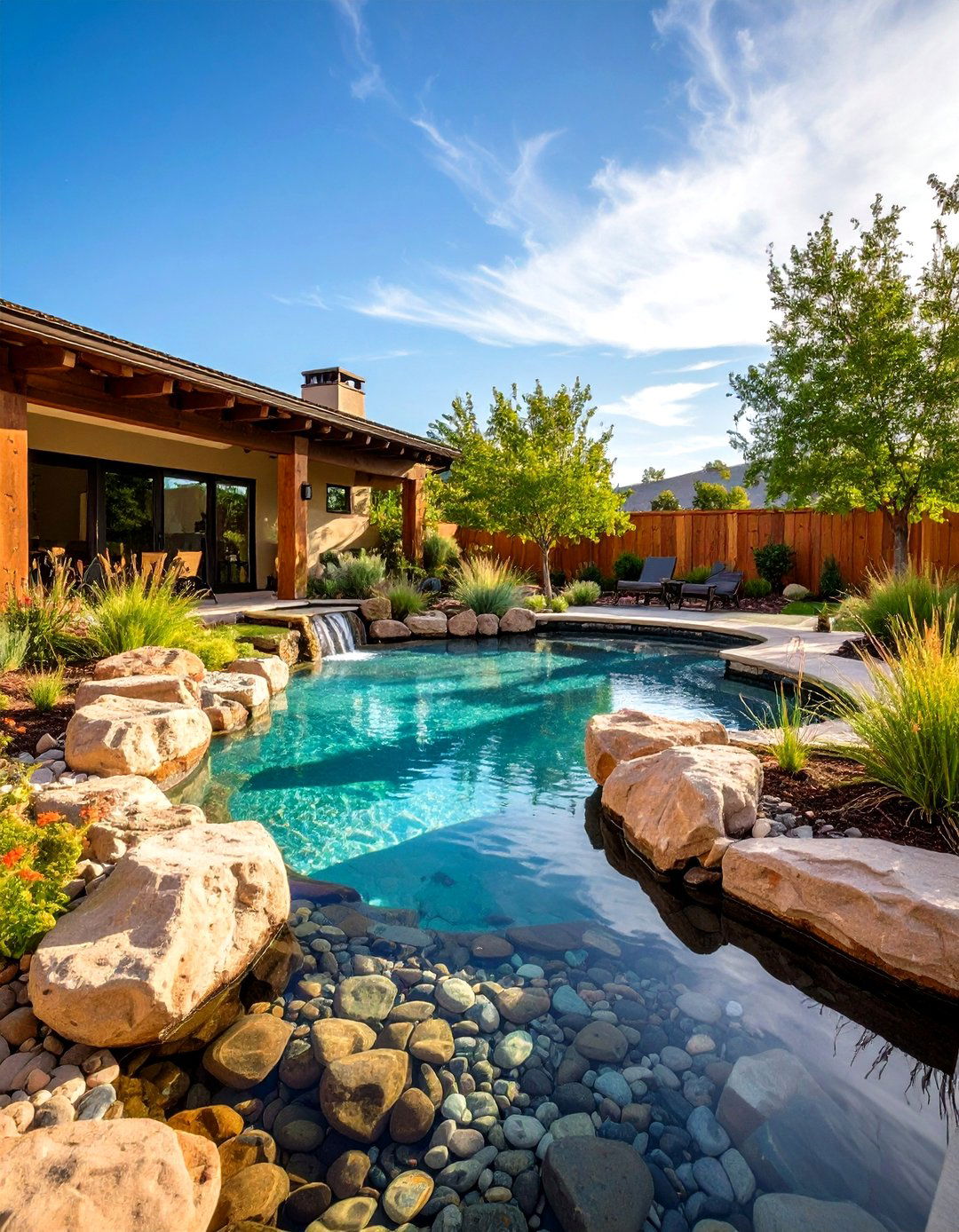
Leave a Reply